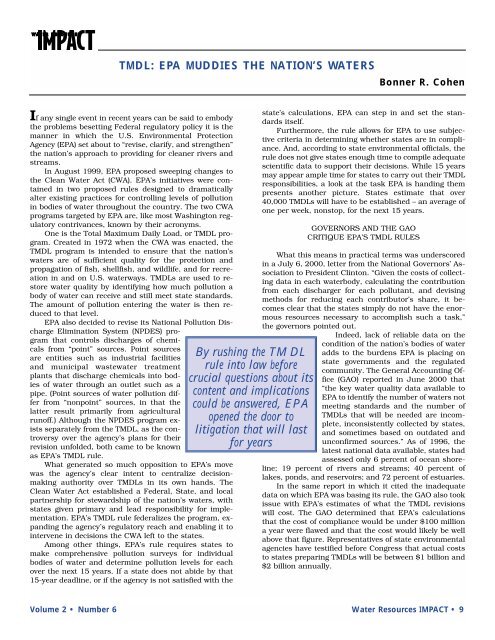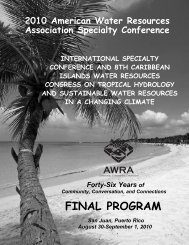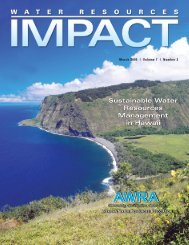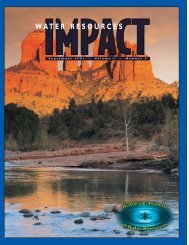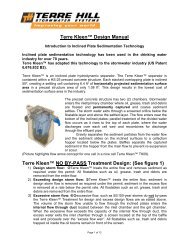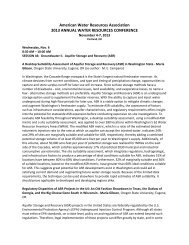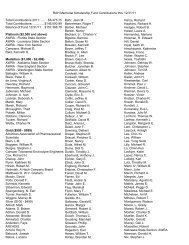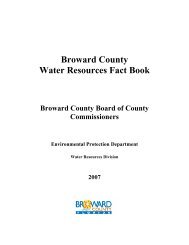N ovember 2 0 0 0 ⢠V olume 2 ⢠N umber 6 - American Water ...
N ovember 2 0 0 0 ⢠V olume 2 ⢠N umber 6 - American Water ...
N ovember 2 0 0 0 ⢠V olume 2 ⢠N umber 6 - American Water ...
Create successful ePaper yourself
Turn your PDF publications into a flip-book with our unique Google optimized e-Paper software.
TMDL: EPA MUDDIES THE NATION’S WATERS<br />
Bonner R. Cohen<br />
If any single event in recent years can be said to embody<br />
the problems besetting Federal regulatory policy it is the<br />
manner in which the U.S. Environmental Protection<br />
Agency (EPA) set about to “revise, clarify, and strengthen”<br />
the nation’s approach to providing for cleaner rivers and<br />
streams.<br />
In August 1999, EPA proposed sweeping changes to<br />
the Clean <strong>Water</strong> Act (CWA). EPA’s initiatives were contained<br />
in two proposed rules designed to dramatically<br />
alter existing practices for controlling levels of pollution<br />
in bodies of water throughout the country. The two CWA<br />
programs targeted by EPA are, like most Washington regulatory<br />
contrivances, known by their acronyms.<br />
One is the Total Maximum Daily Load, or TMDL program.<br />
Created in 1972 when the CWA was enacted, the<br />
TMDL program is intended to ensure that the nation’s<br />
waters are of sufficient quality for the protection and<br />
propagation of fish, shellfish, and wildlife, and for recreation<br />
in and on U.S. waterways. TMDLs are used to restore<br />
water quality by identifying how much pollution a<br />
body of water can receive and still meet state standards.<br />
The amount of pollution entering the water is then reduced<br />
to that level.<br />
EPA also decided to revise its National Pollution Discharge<br />
Elimination System (NPDES) program<br />
that controls discharges of chemicals<br />
from “point” sources. Point sources<br />
are entities such as industrial facilities<br />
and municipal wastewater treatment<br />
plants that discharge chemicals into bodies<br />
of water through an outlet such as a<br />
pipe. (Point sources of water pollution differ<br />
from “nonpoint” sources, in that the<br />
latter result primarily from agricultural<br />
runoff.) Although the NPDES program exists<br />
separately from the TMDL, as the controversy<br />
over the agency’s plans for their<br />
revision unfolded, both came to be known<br />
as EPA’s TMDL rule.<br />
What generated so much opposition to EPA’s move<br />
was the agency’s clear intent to centralize decisionmaking<br />
authority over TMDLs in its own hands. The<br />
Clean <strong>Water</strong> Act established a Federal, State, and local<br />
partnership for stewardship of the nation’s waters, with<br />
states given primary and lead responsibility for implementation.<br />
EPA’s TMDL rule federalizes the program, expanding<br />
the agency’s regulatory reach and enabling it to<br />
intervene in decisions the CWA left to the states.<br />
Among other things, EPA’s rule requires states to<br />
make comprehensive pollution surveys for individual<br />
bodies of water and determine pollution levels for each<br />
over the next 15 years. If a state does not abide by that<br />
15-year deadline, or if the agency is not satisfied with the<br />
By rushing the TMDL<br />
rule into law before<br />
crucial questions about its<br />
content and implications<br />
could be answered, EPA<br />
opened the door to<br />
litigation that will last<br />
for years<br />
state’s calculations, EPA can step in and set the standards<br />
itself.<br />
Furthermore, the rule allows for EPA to use subjective<br />
criteria in determining whether states are in compliance.<br />
And, according to state environmental officials, the<br />
rule does not give states enough time to compile adequate<br />
scientific data to support their decisions. While 15 years<br />
may appear ample time for states to carry out their TMDL<br />
responsibilities, a look at the task EPA is handing them<br />
presents another picture. States estimate that over<br />
40,000 TMDLs will have to be established – an average of<br />
one per week, nonstop, for the next 15 years.<br />
GOVERNORS AND THE GAO<br />
CRITIQUE EPA’S TMDL RULES<br />
What this means in practical terms was underscored<br />
in a July 6, 2000, letter from the National Governors’ Association<br />
to President Clinton. “Given the costs of collecting<br />
data in each waterbody, calculating the contribution<br />
from each discharger for each pollutant, and devising<br />
methods for reducing each contributor’s share, it becomes<br />
clear that the states simply do not have the enormous<br />
resources necessary to accomplish such a task,”<br />
the governors pointed out.<br />
Indeed, lack of reliable data on the<br />
condition of the nation’s bodies of water<br />
adds to the burdens EPA is placing on<br />
state governments and the regulated<br />
community. The General Accounting Office<br />
(GAO) reported in June 2000 that<br />
“the key water quality data available to<br />
EPA to identify the n<strong>umber</strong> of waters not<br />
meeting standards and the n<strong>umber</strong> of<br />
TMDLs that will be needed are incomplete,<br />
inconsistently collected by states,<br />
and sometimes based on outdated and<br />
unconfirmed sources.” As of 1996, the<br />
latest national data available, states had<br />
assessed only 6 percent of ocean shoreline;<br />
19 percent of rivers and streams; 40 percent of<br />
lakes, ponds, and reservoirs; and 72 percent of estuaries.<br />
In the same report in which it cited the inadequate<br />
data on which EPA was basing its rule, the GAO also took<br />
issue with EPA’s estimates of what the TMDL revisions<br />
will cost. The GAO determined that EPA’s calculations<br />
that the cost of compliance would be under $100 million<br />
a year were flawed and that the cost would likely be well<br />
above that figure. Representatives of state environmental<br />
agencies have testified before Congress that actual costs<br />
to states preparing TMDLs will be between $1 billion and<br />
$2 billion annually.<br />
V<strong>olume</strong> 2 • N<strong>umber</strong> 6 <strong>Water</strong> Resources IMPACT • 9


